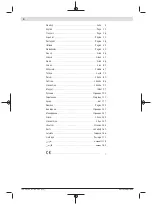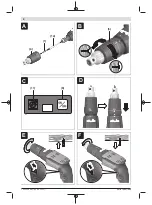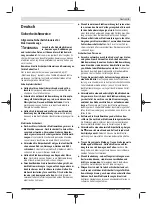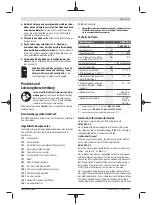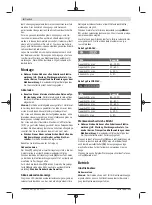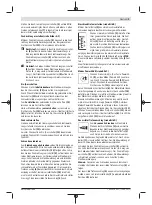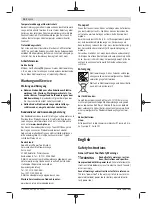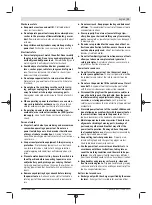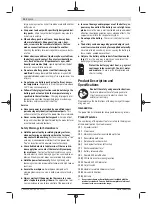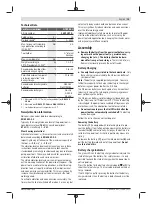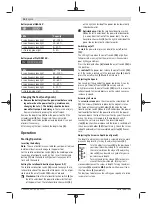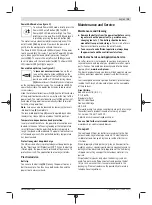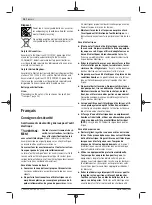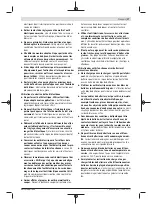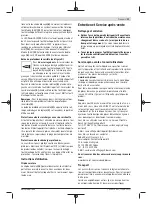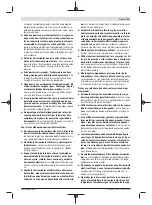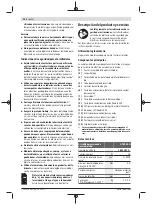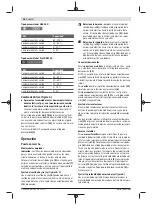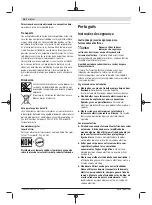
English |
13
Technical Data
Cordless screwdriver
GTB 185-LI
Article number
3 601 JK7 0..
Rated voltage
V=
18
No-load speed
A)
min
-1
0–4500
Max. torque, soft screwdriv-
ing application according to
ISO 5393
A)
Nm
5.0
Tool holder
¼" internal
hexagon
Max. screw diameter
mm
6
Weight according to
EPTA-Procedure 01:2014
B)
kg
1,3–2,3
Recommended ambient tem-
perature during charging
°C
0 to +35
Permitted ambient temperat-
ure during operation
C)
and
during storage
°C
–20 to +50
Recommended rechargeable
batteries
GBA 18V...
ProCORE18V...
Recommended chargers
GAL 18...
GAX 18..
GAL 36...
A) Measured at 20–25 °C with rechargeable battery
GBA 18V
2.0Ah
.
B) Measured with
GBA 18V 1.5Ah
and
GBA 18V 12Ah
.
C) Limited performance at temperatures < 0 °C
Noise/vibration information
Noise emission values determined according to
EN 62841-2-2
.
Typically, the A-weighted noise level of the power tool is:
Sound pressure level
76
dB(A); sound power level
87
dB(A). Uncertainty K =
3
dB.
Wear hearing protection!
Vibration total values a
h
(triax vector sum) and uncertainty K
determined according to
EN 62841-2-2
:
Impact tightening of fasteners of the maximum capacity of
the tool: a
h
<
2.5
m/s
2
, K =
1.5
m/s
2
The vibration level and noise emission value given in these
instructions have been measured in accordance with a
standardised measuring procedure and may be used to com-
pare power tools. They may also be used for a preliminary
estimation of vibration and noise emissions.
The stated vibration level and noise emission value repres-
ent the main applications of the power tool. However, if the
power tool is used for other applications, with different ap-
plication tools or is poorly maintained, the vibration level
and noise emission value may differ. This may significantly
increase the vibration and noise emissions over the total
working period.
To estimate vibration and noise emissions accurately, the
times when the tool is switched off or when it is running but
not actually being used should also be taken into account.
This may significantly reduce vibration and noise emissions
over the total working period.
Implement additional safety measures to protect the oper-
ator from the effects of vibration, such as servicing the
power tool and application tools, keeping their hands warm,
and organising workflows correctly.
Assembly
u
Remove the battery from the power tool before carry-
ing out work on the power tool (e.g. maintenance,
changing tool, etc.). The battery should also be re-
moved for transport and storage.
There is risk of injury
from unintentionally pressing the on/off switch.
Battery Charging
u
Use only the chargers listed in the technical data.
Only
these chargers are matched to the lithium-ion battery of
your power tool.
Note:
The battery is supplied partially charged. To ensure
full battery capacity, fully charge the battery in the charger
before using your power tool for the first time.
The lithium-ion battery can be charged at any time without
reducing its service life. Interrupting the charging process
does not damage the battery.
The lithium-ion battery is protected against deep discharge
by the "Electronic Cell Protection (ECP)". When the battery
is discharged, the power tool is switched off by means of a
protective circuit: The application tool no longer rotates.
u
Do not continue to press the On/Off switch after the
power tool has automatically switched off.
The battery
can be damaged.
Follow the instructions on correct disposal.
Removing the battery
The battery
(7)
is equipped with two locking levels to pre-
vent the battery from falling out when pushing the battery re-
lease button
(8)
unintentionally. As long as the battery is in-
serted in the power tool, it is held in position by means of a
spring.
To remove the battery
(7)
, press the release button
(8)
and
pull the battery forward and out of the power tool.
Do not
use force to do this.
Battery charge indicator
The green LEDs on the battery charge indicator indicate the
state of charge of the battery. For safety reasons, it is only
possible to check the state of charge when the power tool is
not in operation.
Press the button for the battery charge indicator or
to
show the state of charge. This is also possible when the bat-
tery is removed.
If no LED lights up after pressing the button for the battery
charge indicator, then the battery is defective and must be
replaced.
Bosch Power Tools
1 609 92A 6HJ | (23.09.2021)


